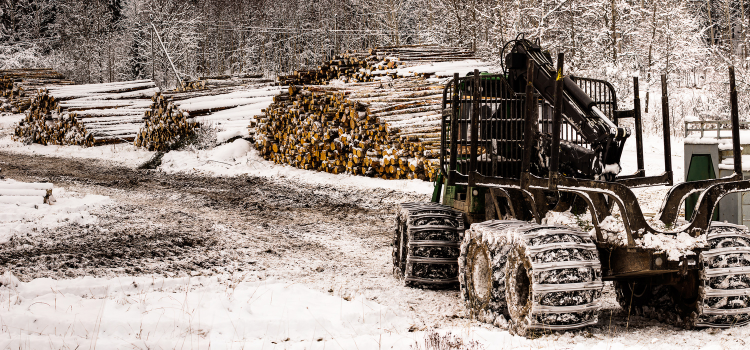How to Prepare Your Forestry Machines for WinterPosted: 2020-11-24
The extremely cold conditions brought about by winter do not only affect humans and living things; they also impact non-living things, and forestry machines are no exemption. This season offers a new level of difficulty to heavy equipment and operators. Tasks that are relatively easy during warmer seasons become very challenging when temperatures drop. To avoid the adverse effects of winter on your forestry machines, consider these tips. Routine Inspections To ensure your heavy equipment performs well during this season, you need to perform routine inspections in key parts such as engine parts, fluids, the battery, lights, windshield wipers, brakes, joints, hinges, glass, mirrors, and the body. It’s best to consult your operator’s manual to find out how to properly choose the right engine oil, coolant, and other fluids. If you discover any issues or dirt during an inspection, you may need to perform preventive maintenance steps right away. Checking the above parts and making the necessary adjustments should be performed to prepare your forestry machines for the cold season. Hydraulic Hose Conditioning Hydraulic hoses play an important role in your machines’ hydraulic system. Their integrity is essential to the overall functioning of the system. Extremely cold weather can also affect the rubber hoses in your machines. When the rubber is cooled for extended periods, the physical properties and its bending capacity will change even if it has been engineered for cold environments. When this happens, your hoses may no longer behave with their normal characteristics and become stiff and unyielding. To condition your hydraulic hoses, run the motor to raise the hydraulic oil to 150 degrees Fahrenheit, and let the machine run for at least one hour. For best results, use a specially formulated arctic hydraulic oil during winter. Battery Maintenance During winter, batteries have less pulling voltage, which means there is more pressure on the engine during start-up. When the temperature goes sub-zero, the pressure on the engine can increase by as much as 50 percent. As a result, your batteries will cause your heavy equipment to have issues starting or maintaining power. To ensure your batteries do not cause any problems, keep them fully charged and warm. If work is going to be on hold due to extremely cold weather, consider removing the batteries and keep them charged in storage. Be sure that the storage area is not subject to freezing or high temperatures. Also, consider buying a smart charger, which can maintain a battery at normal levels for long storage periods. Coolant Adjustment Even your coolant faces challenges during winter. Thankfully, there are things you can do to see whether your coolant is enough to get you through the season. Visually check the antifreeze (coolant). Determine its physical qualities. Does it look bright and vivid, or is it brown and spongy? The latter indicates the coolant is nearing the end of its usefulness. You will need to flush your cooling system and replace the coolant. Select an antifreeze that can handle the expected coldness in your area. Tire Inflation As mentioned earlier, even rubber items are affected by extremely cold weather — this includes your tires, specifically, in terms of losing air pressure quicker. For every 10 degrees of temperature drop, tires will lose 1-2 pounds of pressure. Therefore, it is critical to make sure they are filled to the right psi (pounds per square inch) for your machine. Check your operator’s manual for the proper psi to maintain traction. Inflate your tires in a heated area and consider using dry nitrogen gas to eliminate ice crystals. Undercarriage Inspection The undercarriage may be a challenging part to inspect and maintain, but failure to do so can cause serious problems. It supports the total weight of the machine and is continuously exposed to rocks and other barriers during operation. Several of its parts are subjected to constant wear and tear. That’s why keeping the undercarriage in great shape increases the level of safety and efficiency of the machine. In case the machine has been buried up in the snow for extended periods, contact a professional to inspect it before restarting operations. Perform these safety inspections and maintenance steps to ensure hassle-free operations even during frosty days in the forest.
| |






.jpg)
